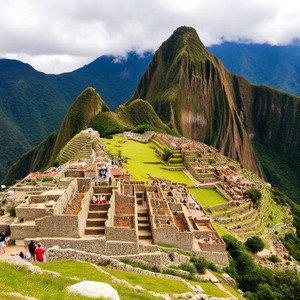Machu Picchu, one of the most iconic archaeological sites in the world, continues to capture the imaginations of travelers from all corners of the globe. Perched high in the Peruvian Andes at nearly 8,000 feet above sea level, this ancient Incan city was built in the 15th century and remained hidden from the outside world until its rediscovery by American historian Hiram Bingham in 1911. Today, it stands as a UNESCO World Heritage site, offering visitors an extraordinary glimpse into the rich history and culture of the Incas.
The journey to Machu Picchu is an adventure in itself, whether you opt to hike the Inca Trail or take the train to Aguas Calientes and then a bus up to the site. The Inca Trail is one of the most sought-after treks in the world, spanning 26 miles and taking about four days to complete. Along the way, hikers pass through lush forests, cross ancient Incan ruins, and are rewarded with breathtaking views of the surrounding mountains and valleys. For those with less time or physical endurance, the train ride offers an equally scenic route, winding through the Sacred Valley and providing a comfortable way to reach the foot of the mountain.
Upon arrival at Machu Picchu, visitors are immediately struck by the site’s awe-inspiring beauty and its remarkable preservation. The stone terraces, temples, and plazas are a testament to the advanced engineering and architectural skills of the Inca civilization. One of the most notable structures is the Intihuatana stone, often referred to as the “Hitching Post of the Sun.” This ceremonial stone was believed to have been used by the Incas for astronomical observations and to mark the solstices. The combination of natural beauty and ancient architecture creates a truly magical atmosphere that feels both serene and spiritual.
The panoramic views from Machu Picchu are nothing short of spectacular. Surrounded by steep cliffs and lush green valleys, the site offers an unparalleled perspective of the Andean mountain range. The mist that often envelops the peaks in the early morning adds an air of mystery to the experience, as if the city itself is still emerging from the clouds. For many visitors, the highlight is watching the sunrise over the ruins, casting golden light on the ancient stones and illuminating the surrounding landscape.
Machu Picchu is more than just a tourist destination; it is a cultural and historical treasure. The site was likely a royal estate or religious retreat, though its exact purpose remains a subject of debate among historians. The Incas built the city with a deep understanding of the natural environment, incorporating elements of astronomy, agriculture, and geology into its design. Many of the buildings align with celestial events, showcasing the Incas’ sophisticated knowledge of the cosmos. Walking through Machu Picchu, visitors are reminded of the ingenuity of a civilization that thrived for centuries before mysteriously disappearing.
While visiting Machu Picchu is an unforgettable experience, it’s important to remember that preserving this ancient wonder is crucial. To ensure the site’s conservation, visitor numbers are limited each day, and regulations are in place to protect the integrity of the ruins. Visitors are encouraged to respect the site by following the guidelines and participating in the ongoing efforts to preserve this world-renowned cultural heritage for future generations. Whether you’re a history enthusiast, an adventurer, or simply someone seeking natural beauty, Machu Picchu offers a profound and unforgettable experience.

Leave a Reply